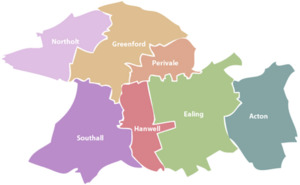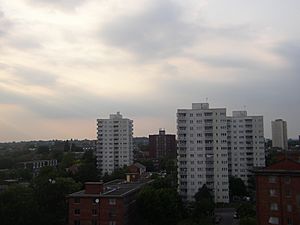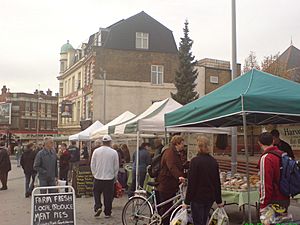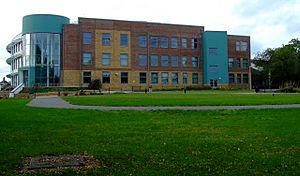Acton, London facts for kids
Quick facts for kids Acton |
|
|---|---|
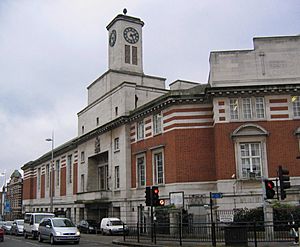 Acton Town Hall, built for Acton Urban District and opened 10 March 1910 |
|
| Area | 9.20 km2 (3.55 sq mi) |
| Population | 62,480 |
| • Density | 6,791/km2 (17,590/sq mi) |
| OS grid reference | TQ205805 |
| • Charing Cross | 6.1 mi (9.8 km) W |
| London borough | |
| Ceremonial county | Greater London |
| Region | |
| Country | England |
| Sovereign state | United Kingdom |
| Post town | LONDON |
| Postcode district | W3, W4, W12 |
| Postcode district | NW10 |
| Dialling code | 020 |
| Police | Metropolitan |
| Fire | London |
| Ambulance | London |
| EU Parliament | London |
| UK Parliament |
|
| London Assembly |
|
Acton is a town in West London, England. It is part of the London Borough of Ealing. Acton is about 6.1 miles (9.8 km) west of Charing Cross, a central point in London.
In 2011, the population of Acton was 62,480 people. This was a big increase of almost 9,000 people in ten years. Acton includes several smaller areas like North Acton, West Acton, East Acton, and South Acton.
The name Acton means "oak farm" or "farm by oak trees." It comes from old English words. Acton was once a small village. As London grew, Acton became a part of the big city. Since 1965, most of Acton is in the London Borough of Ealing. However, small parts are in other boroughs.
Central Acton used to be a busy area for shops and businesses. It was on the main road between London and Oxford. Many old inns, some from the 1500s, were stopping places for travelers. Today, the main road to Oxford (the A40) goes around central Acton. But it still passes through East Acton and North Acton.
Contents
What's in a Name?
Acton's name comes from two Old English words. āc means "oak" and tūn means "enclosed garden" or "enclosure." So, it means "a garden or field surrounded by oak trees." Later, tūn also meant "farm."
For many centuries, Acton was called Church Acton. This helped tell it apart from a nearby small village called East Acton.
Acton's Story
Early Times
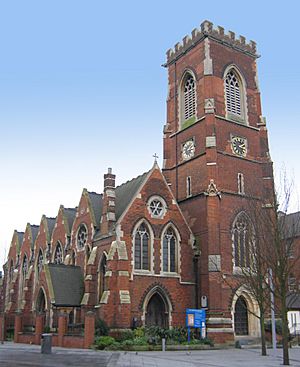
People have lived in the Acton area for a very long time. Tools and items from the Stone Age and Bronze Age have been found here. These show that people lived and farmed in the area.
There were also signs of people from the Iron Age and Roman times. In the Middle Ages, the northern part of Acton had many trees. Most of these woodlands were cleared by the 1600s.
Medieval Period
Records show that people owned land in Acton by 1222. Houses were also recorded from the late 1200s. The main village, Church Acton, was along the main road to Oxford. By the late 1300s, some buildings along this road became inns. These inns, like The Tabard, offered places for travelers to stay.
East Acton was another small settlement. It had farmhouses and cottages around a common area called East Acton green. Most of the farms were along the Oxford road. Londoners started buying land in Acton in the 1300s. But they didn't live there until the late 1400s.
Early Modern Period
By the 1600s, Acton was a popular summer spot for rich people and lawyers. It was close to London but offered fresh air. People like Sir Richard Sutton and Sir Henry Garraway bought homes here. Sir John Trevor bought several properties. He even added a lake and stream to his home.
In the 1700s, Acton became known for its special water. People believed the water from the wells at Old Oak common had healing powers. This brought many summer visitors to the area. Even after the very rich left, many doctors and military people bought houses in Acton. Acton Green also became popular. It was close to a main road called Chiswick High Road.
19th Century Growth
In 1812, the Worshipful Company of Goldsmiths built twenty almshouses in Acton. These were homes for poor people.
Acton grew a lot in the 1800s. In 1801, there were 241 houses. By 1831, there were 426 houses. Most of this growth was in Acton town and East Acton. Acton was still mostly countryside in 1831.
In the 1850s, more building projects began. Acton became famous for its laundries because it had soft water. By the late 1800s, there were about 170 laundries in South Acton. They washed clothes for hotels and wealthy people in London. This gave Acton the nickname "Soapsuds Island." The last laundry closed in the 1970s.
Acton became an urban district in 1894. This meant it had its own local government. In 1895, Acton Cemetery opened.
20th Century Changes
In 1921, Acton became a borough. This meant it had more power to govern itself. But in 1965, Acton joined with Ealing and Southall. Together, they formed the London Borough of Ealing.
During the 1900s, Acton was a big industrial area. Many factories made cars and car parts. Tens of thousands of people worked here. Famous companies like Renault made cars in North Acton from 1926 to 1960. Renault still has a showroom there today.
Other well-known companies in Acton Vale included Napier & Son (engines) and Wilkinson Sword (swords and razors).
Acton Today
Today, Acton is mostly a place where people live. But it still has some light industry. This is especially true in the Park Royal area and near Chiswick. Waitrose, a well-known supermarket, started in Acton. Its first store was on the High Street.
Acton is home to the largest housing estate in west London. This is the South Acton estate. It has about 2,000 homes and 5,800 residents. This area is currently being rebuilt. Old homes are being replaced with new ones.
Acton has a diverse population. Many people from Poland have lived here since World War II. More recently, people from Australia, South Africa, and Japan have moved to Acton. The Japanese School in London is in West Acton. The King Fahd Academy in East Acton attracts people from Arab countries. There is also a Somali community and two mosques.
Acton will be the starting point for the Thames Tideway Scheme. This is a huge tunnel project. It will help stop sewage from flowing into the River Thames.
Fun in Acton
The 'Mount' on Acton High Street has a market on Thursdays, Fridays, and Saturdays. You can find many different things to buy there. Acton also has a library, swimming baths, and a Town Hall. These are all grand Victorian buildings on the High Street.
The Acton Swimming Baths were closed for a few years for a big upgrade. They reopened in 2014 with new pools. An indoor climbing wall also opened on the High Street. It is in a building that used to be an Art Deco cinema.
Acton Park is at the east end of Acton High Street. It has mini golf, a restaurant, and tennis courts. There is also outdoor fitness equipment. Kids can enjoy a large play area and an adventure playground. The park also has a pond and the Acton Skate Park.
Learning in Acton
Primary Schools
Acton has six state-funded primary schools. These include Berrymede Junior School and East Acton Primary School. Two new primary schools, Ark Priory Primary Academy and Ark Byron Primary Academy, have also opened.
Secondary Schools
There are three state-funded secondary schools in Acton. These are Ark Acton Academy (formerly Acton High School), Twyford Church of England High School, and The Ellen Wilkinson School for Girls.
International Schools
The Japanese School in London is located in Acton.
Famous People from Acton
Many well-known people have lived or grown up in Acton.
- Jamal Edwards, who started the music platform SB.TV.
- Mathangi Arulpragasam, known as the rapper M.I.A.
- Peter Ackroyd, a famous writer.
- John Entwistle and Pete Townshend from the band The Who.
- Adam Faith, a singer and actor.
- Emilia Fox and Kit Harington, both actors.
- Alan Rickman, another well-known actor.
- Simon Reeve, a TV presenter.
- Alan Wilder, a former member of the band Depeche Mode.
- Asma al-Assad, the former First Lady of Syria.
Getting Around Acton
Train and Tube Stations
Acton has many train and tube stations. In fact, it has more stations with its name than almost any other place in the UK, except London itself. Acton is also the only place in London with stations named after all four directions: North, South, East, and West.
Stations in the area include:
- Acton Central railway station
- Acton Main Line railway station (on the Elizabeth line)
- Acton Town Underground station (District line and Piccadilly line)
- East Acton Underground station (Central line)
- North Acton Underground station (Central line)
- South Acton railway station
- West Acton Underground station (Central line)
The London Transport Museum Depot is also in Acton. It holds a large collection of old trains and buses.
Buses
Many London bus routes serve Acton. These include routes 7, 70, 94, 207, and many others.
Past Tram Plans
There were plans to build a tram line through Acton. It would have run along the Uxbridge Road. However, these plans were stopped. Instead, the Crossrail project went ahead. This project brought the new Elizabeth line to Acton Main Line station.
Nearby Places
- Chiswick
- Ealing
- Harlesden
- Park Royal
- Shepherd's Bush
- North Acton
- South Acton
- East Acton
- West Acton
Images for kids
See also
 In Spanish: Acton (Londres) para niños
In Spanish: Acton (Londres) para niños



